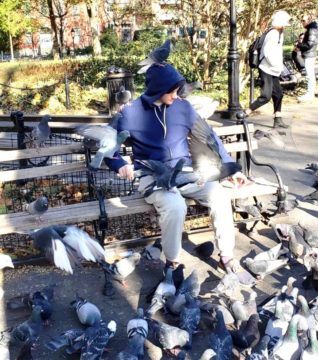by Ethan Seavey

I sit in Parc des Buttes-Chaumont in this the 19th and penultimate arrondissement. We are a pocket of American students lounging down by the perfectly circular pond. We rehash old jokes in unapologetic English which go unheard by the hundreds of Parisians sitting on the hill like Greek citizens watching lesser and stupider gods. It is the weekend so we cross the city on the Métro and by pure luck make it to our destination and once we’ve arrived we mispronounce the name of this handsome park.
Right at the edge of the water stands a man who rips off pieces of bread from the bakery and throws them to the mallards who flock before him. The duck man loves them and they return the feeling. But he so hates the pigeons which walk up to him on the grass and seek the crumbs he throws to the mallards. When they approach he kicks at them; and if they watch from nearby, he chases them with a fallen bough from a horse chestnut tree. He smokes something that is not tobacco and is not cannabis. It smells pleasant enough. It makes him more relaxed and still more vicious towards the approaching pigeons.
We sit by the water and some of us watch him. We are New Yorkers though most of us have only been in New York for a year or two because our time spent studying at Washington Square was cut short by the pandemic. And in New York at Washington Square there is no duck man and there is the pigeon man. We loved to see him enveloped by the purple green flashes of gray feathered flock. He let every oil-slicked feral disfigured city bird onto his lap and onto his shoulder and head.
In New York I hated pigeons and loved the pigeon man. One day on a writing assignment I bought a sweatshirt from Goodwill and I sat on the pigeon man’s favorite bench and threw seeds into the air so the birds would flock around me. Eventually they learned to trust me enough to climb onto my thighs and the hood atop my head. Still I fear the pigeons but now I notice them.
The Parisian pigeon is far more beautiful than the New York pigeon. It is cleaner and fatter and its feathers flash a brighter purple and green. You see these pigeons as real birds with nests and chicks and peahens which are bigger and coo in the bushes. You see dead pigeons too and there are none in New York. In New York pigeons do not die and they do not love. They sometimes have sex in front of you as you eat lunch in the park but because you do not see any eggs or babies you assume it is a fruitless and mechanical desire that changes nothing in their tired immortality.
And of course mallards are the same here as they are in Central Park. They stick to ponds and lakes and dive sometimes. They are sweet-looking but keep their distance—not out of respect but out of distrust. Pigeons are kicked by man every day and still find the room in their hearts to climb over us and to ask the duck man for more crumbs even as his face wrinkles with rage and he swings his toe at their heads. They fly off and return and they fly off and forgive because this man loves the birds and maybe one day he will realize that they are as interesting as ducks.
The pigeons really fly here. I hadn’t noticed their flight in America but here they fly as though they are happy to have wings, or as if they’d recently grown them and still find pleasure in cutting through the open skies of Paris. In New York they move mechanically through the sky and their paths are dammed up with buildings. You sit in a park and you notice a flock pecking seeds and you watch a child fling himself at them. He watches them move from the park to the green awning of the bank; to the windows of apartments; and back to the park where they resume their pecking until the child returns again and they fly as a unit to the same three spots and they fly bored and enslaved by their coded program.
And here the duck man hates these pigeons though they are free and proud—-and now soar happily around the pond. Now landing atop the stone gazebo of yesterday, now dipping their breasts under the wake and now climbing higher into nothingness. They return but never fall into a mundane flight path. They will flirt with the man who hates them so and cut fresh paths into the air. Most Parisians will not notice them because they have always been this beautiful. The people here speak a different language but they are the same because they wear their phones close to their face.
In Paris the pigeon is a rat. In New York they are unwanted because they are filthy and scientists say they carry sickness and plague but they are not as bad as rats. Of course there are rats in both cities but this is beside the point. Looking at the Parisian pigeon, I see nothing so offensive as the ones in New York which gather so much love. And yet somewhere here they are breeding an army of eagles to tear each one apart.
